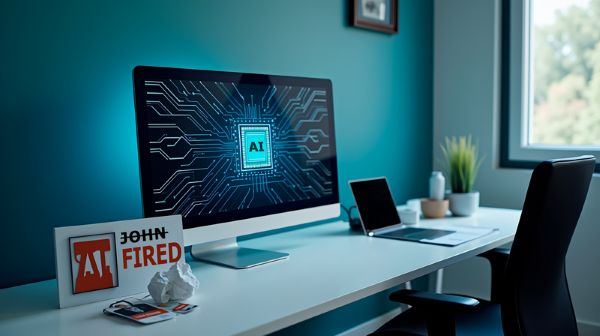The latest Metatrends, states Peter Diamandis, of XPrize fame, show we are quickly approaching a point where artificial intelligence (AI) in the workplace will mean job descriptions and job types are changing. Does this mean fewer high-paying traditional white-collar jobs? Yes. Does it also mean that AI will create whole new types of jobs? Yes to that too!
Every week, Diamandis publishes his Metatrends newsletter with his predictions about what lies ahead in the next decade. The latest newsletter talks about “the dematerialization of white-collar jobs.”

Is AI coming for your job?
The CEO of Anthropic, Dario Amodei, thinks so. He has issued a blunt warning to the American government and businesses: AI could wipe out half of all entry-level white collar jobs in the next five years.
As evidence to support his argument, look at over 40% of Microsoft’s most recent layoffs involving white-collar software engineers, including directors in AI-related positions.
Metatrends forecasts that by 2030, about 30% of white-collar jobs will be fundamentally transformed by AI.
Recently, OpenAI introduced Codex, a cloud-based software engineering agent capable of handling various tasks simultaneously for coders. Similar trends are happening with customer service jobs, and it is only a matter of time before humanoid robots with onboard AI take on manual labour. Right now, those jobs are temporarily spared because of the speed these robots do the job that humans can do. That, too, is changing with companies like Toyota and BMW reporting improvements in both production speed and quality on assembly lines. These robots are also capable of continuous work, 24/7, unlike their human counterparts.
Diamandis argues that white-collar job displacement is here and now as AI redefines productivity.
1. Universal Basic Income Becomes Adopted By Governments
As AI displaces human capital across industries, we’re heading toward some version of government-issued UBI. A way to fund this could be to tax the profits of companies adopting AI. The taxes raised could pay for UBI and the retraining of displaced workers.
2. Single Person AI-Powered Companies Will Define The Future
By 2030, expect AI systems to create entire autonomous businesses. AI-run law firms, marketing agencies, and medical offices will operate 24/7. The Bradley Sacks Semafor chart appearing above tells the story of revenue-per-employee at S&P 500 companies, which has plummeted from eight employees to generate $1 million in the 1980s to just two today. Expect a future of one-person companies with entrepreneurs conceiving a vision and using AI to orchestrate and handle everything rather than trying to compete with it.
3. The Great Demonetization is Coming
Here’s what most miss. As jobs transform, so will living costs. Healthcare, education, therapy, and childcare will undergo radical demonetization. UBI will be part of this demonetization, while AI will make quality services more abundant and dramatically less expensive. This will help offset job displacement.
4. People Will Find Their MTP
Diamandis talks about discovering the Massively Transformative Purpose (MTP) of your existence in many talks he gives at Singularity University. MTP refers to the ambition and fundamental reason for a company’s existence. Entrepreneurs who leverage AI will thrive in this new economy as company formation and acquisition cycles accelerate beyond anything previously seen. As businesses replace employees with AI, efficiency metrics will skyrocket. What Diamandis advocates is to stop thinking about looking for another job and, instead, start finding your MTP and creating value by solving problems that you care deeply about.
5. The Key Is To Develop a Curiosity Mindset
In a world of ubiquitous AI, the quality of the questions you ask has more value than memorization and rote learning. When I was teaching people how to sell in my previous existence working at an educational publishing company, I stated that those who excel in their jobs learn to ask “W5 and How” questions. All these open-ended questions unlock a future of possibilities. Not familiar with W5? These are questions that begin with “Who? What? Where? Why? and How?” They are essential to developing a Curiosity Mindset. They allow the questioner to approach the unknown with wonder rather than assumptions. In a world where AI disrupts those who are just rote learners, the Curiosity Mindset will become your ultimate competitive advantage, as it has been for top-performing salespeople through the years.
Other Advice For Society and Governments
Amodei states in the Axios interview that, “We, as the producers of this technology, have a duty and an obligation to be honest about what is coming. I don’t think this is on people’s radar.” He outlines three strategies for society and governments to adopt to pre-empt the AI threat. They are:
- AI companies and governments have a responsibility to communicate to the public what the transformative impact of this technology will have on jobs and the future of work.
- Employers have to develop programs and policies to help their workers through the AI transition rather than deal with layoffs, leaving an economy with rising levels of unemployment.
- There is a need for a public, ongoing debate to create policy solutions for the upcoming AI-dominated economy that is fast approaching.
Amodei, like Diamandis, suggests an AI surtax. Amodei sees a 3% “token tax” on company earnings coming from the use of AI as a way to fund programs to deal with transitioning to a super-intelligence-dominated economy. Diamandis’ ideas, UBI, developing a Curiosity Mindset, and identifying a person’s MTP could all benefit from programs receiving money from an AI surtax.









